The velocity of a particle varies with time as →v=3ˆi+(4−5t)ˆjms−1. Find the average velocity of the particle for a time interval between t=0 and a time when the speed of the particle becomes minimum.
(3ˆi+2ˆj)ms−1
(6ˆi+5ˆj)ms−1
(4ˆi+ˆj)ms−1
(3ˆi−5ˆj)ms−1
The correct Answer is:A
To find the average velocity of the particle for the given time interval, we can follow these steps:
Step 1: Identify the velocity function
The velocity of the particle is given as:
→v=3^i+(4−5t)^jm/s
Step 2: Determine when the speed is minimum
The speed of the particle is given by the magnitude of the velocity vector:
|→v|=√(3)2+(4−5t)2
To find the minimum speed, we need to minimize the expression under the square root:
|→v|2=9+(4−5t)2
To minimize |→v|2, we can differentiate it with respect to time t and set the derivative to zero.
Step 3: Differentiate and find critical points
Differentiating |→v|2:
ddt(9+(4−5t)2)=2(4−5t)(−5)=−10(4−5t)
Setting the derivative to zero:
−10(4−5t)=0⟹4−5t=0⟹t=45s
Step 4: Calculate the average velocity
The average velocity →Vavg over the time interval from t=0 to t=45 is given by:
→Vavg=Δ→sΔt
where Δ→s is the total displacement and Δt is the total time.
Step 5: Calculate total displacement
To find the total displacement, we need to integrate the velocity vector over time:
Δ→s=∫450→vdt=∫450(3^i+(4−5t)^j)dt
Breaking it down:
Δ→s=∫4503^idt+∫450(4−5t)^jdt
Step 6: Evaluate the integrals
1. For the ^i component:
∫4503dt=3t∣∣∣450=3⋅45=125^i
2. For the ^j component:
∫450(4−5t)dt=(4t−5t22)∣∣∣450=⎛⎜
⎜⎝4⋅45−5⋅(45)22⎞⎟
⎟⎠
Calculating this:
=⎛⎝165−5⋅16252⎞⎠=(165−1610)=(165−85)=85^j
Step 7: Combine the components
Thus, the total displacement is:
Δ→s=125^i+85^j
Step 8: Calculate the average velocity
Now, substituting into the average velocity formula:
→Vavg=Δ→sΔt=125^i+85^j45=(125⋅54^i+85⋅54^j)=(3^i+2^j)
Final Answer
The average velocity of the particle is:
→Vavg=3^i+2^jm/s
The velocity of the particle is given as:
→v=3^i+(4−5t)^jm/s
The speed of the particle is given by the magnitude of the velocity vector:
|→v|=√(3)2+(4−5t)2
To find the minimum speed, we need to minimize the expression under the square root:
|→v|2=9+(4−5t)2
To minimize |→v|2, we can differentiate it with respect to time t and set the derivative to zero.
Differentiating |→v|2:
ddt(9+(4−5t)2)=2(4−5t)(−5)=−10(4−5t)
Setting the derivative to zero:
−10(4−5t)=0⟹4−5t=0⟹t=45s
The average velocity →Vavg over the time interval from t=0 to t=45 is given by:
→Vavg=Δ→sΔt
where Δ→s is the total displacement and Δt is the total time.
To find the total displacement, we need to integrate the velocity vector over time:
Δ→s=∫450→vdt=∫450(3^i+(4−5t)^j)dt
Breaking it down:
Δ→s=∫4503^idt+∫450(4−5t)^jdt
1. For the ^i component:
∫4503dt=3t∣∣∣450=3⋅45=125^i
∫450(4−5t)dt=(4t−5t22)∣∣∣450=⎛⎜
⎜⎝4⋅45−5⋅(45)22⎞⎟
⎟⎠
Calculating this:
=⎛⎝165−5⋅16252⎞⎠=(165−1610)=(165−85)=85^j
Thus, the total displacement is:
Δ→s=125^i+85^j
Now, substituting into the average velocity formula:
→Vavg=Δ→sΔt=125^i+85^j45=(125⋅54^i+85⋅54^j)=(3^i+2^j)
The average velocity of the particle is:
→Vavg=3^i+2^jm/s
Topper's Solved these Questions
Similar Questions
Knowledge Check
the angular velocity omega of a particle varies with time t as ω=5t2+25rads. the angular acceleration of the particle att=1s is
A10rads2B5rads2CZeroD3rads2Power supplied to a particle of 1 kg varies with times as P=t22 watt. At t = 0, v= 0, the velocity of the particle at time t = 3s is
A3 m/sB4 m/sC2 m/sD1 m/s
A particle moves rectilinearly with initial velocity u and constant acceleration a. Find the average velocity of the particle in a time interval from t=0 to t=t second of its motion.
View SolutionA particle moves rectilinearly possessing a parabolic s-t graph. Find the average velocity of the particle over a time interval from t=12s→t=1.5s.

View SolutionThe velocity of a particle is given by v=v0sinωt, where v0 is constant and ω=2π/T. Find the average velocity in time interval t=0to t=T/2.
View SolutionDisplacement of a particle of mass 2 kg varies with time as s=(2t2−2t+10)m. Find total work done on the particle in a time interval from t=0 to t=2s.
View SolutionThe velocity of a particle are given by (4t–2) ms–1 along x–axis. Calculate the average acceleration of particle during the time interval from t = 1 to t = 2s.
View SolutionA particle move so that its position verctor varies with time as →r=Acosωtˆi+Asinωtˆj. Find the
a. initial velocity of the particle,
b. angle between the position vector and velocity of the particle at any time, and
c. speed at any instant.
View Solution
